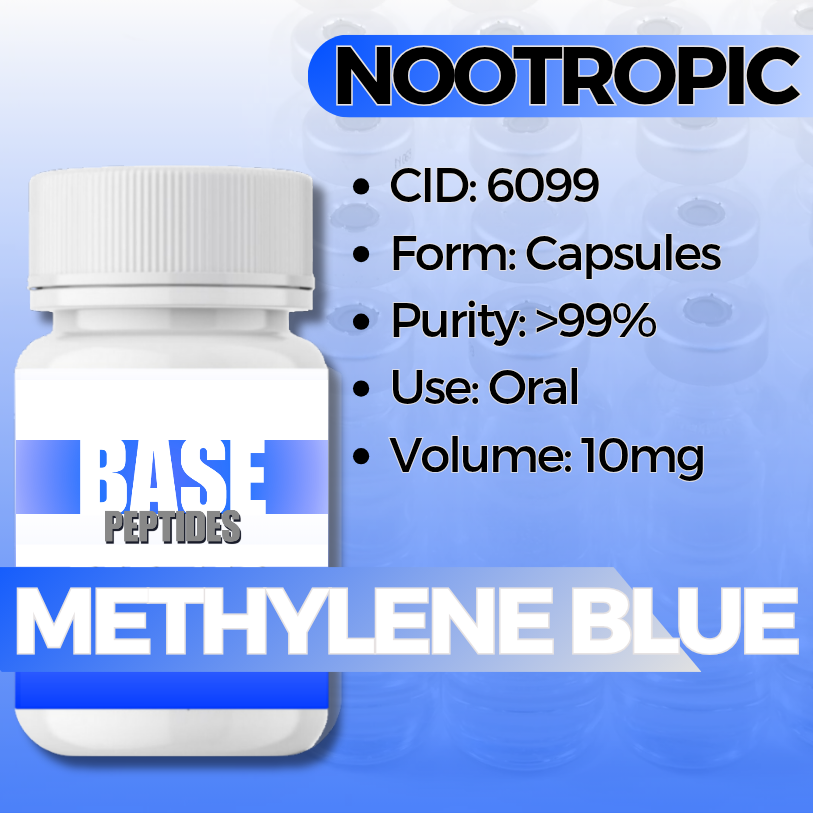Methylene Blue Capsules
Methylene Blue Capsules
Base Peptides are intended for licensed medical professionals and experienced researchers. Reconstitution required. Dosing and use instructions are not provided.
Regular price
$40.00
Regular price
Sale price
$40.00
Shipping calculated at checkout.
Quantity
Couldn't load pickup availability
Methylene Blue (Oral Capsule) – USP/API Grade
Methylene Blue is a synthetic compound historically used in medicine for methemoglobinemia and as a dye. In recent research it is explored for mitochondrial support, cellular energy modulation, and neuro-protective pathways.
Identifiers
- Synonyms: Methylthioninium chloride, MB
- CAS No: 61-73-4
- Formula / MW: C₁₆H₁₈ClN₃S • ~319 g·mol⁻¹
- Class: Redox dye & pharmaceutical agent
How It Works (Plain English)
- Acts in the mitochondria as an alternative electron carrier, improving respiration and reducing reactive oxygen species (ROS).
- Penetrates the blood-brain barrier; in brain research it has been shown to support neural energy, connectivity and cognition in early models.
- Functions as a monoamine oxidase inhibitor (MAOI) in higher doses — important when considering drug interactions.
Why Researchers Use It
- To study mitochondrial dysfunction, aging-biology and oxidative stress.
- To investigate neuro-degenerative diseases (Alzheimer’s, Parkinson’s), memory/learning models.
- To explore redox modulation, cellular protection, and mitochondrial resilience in preclinical settings.
Key Study Themes — What’s Typically Observed
Mitochondrial/Redox Function
- What was tested: Cell and animal models treated with MB; endpoints included mitochondrial respiration, ROS, NADH/NAD⁺ balance.
- What changed: Improved mitochondrial function, lower ROS, stronger cell survival under stress.
- Why it matters: Offers a mechanistic tool for studying energy/aging biology.
Cognitive & Brain Connectivity Models
- What was tested: Low-dose oral MB in healthy subjects (n≈26), measured memory and brain imaging (fMRI).
- What changed: ~7% improvement in correct memory retrieval responses; increased brain-activity in key regions.
- Why it matters: Suggests translational potential, though human data is limited.
Potential Research Applications
Cellular & Mitochondrial Health
- Oxidative stress assays, mitochondrial respiration (OCR/ECAR), NAD⁺/NADH balance.
Neurobiology & Cognitive Models
- Learning/memory tasks, brain connectivity (fMRI), neuro-degenerative models.
Redox Modulation & Aging Biology
- Markers of aging, senescence, cellular stress, telomere/mitochondrial cross-talk.
Known Concerns (Context)
- MAOI Interaction / Serotonin Syndrome Risk: At certain doses MB has monoamine oxidase-inhibiting effects; risk when combined with SSRIs/serotonergic drugs.
- Dose & Toxicity Variation: Wide dose-range in literature (1-300 mg/kg) and risk of hemolysis in G6PD deficiency, methemoglobinemia paradoxically at very high doses.
- Limited Human Evidence: Many claims are early/animal; experts caution human benefit not proven.
- General: Intended for laboratory/research use only unless regulated/approved by health authority in your jurisdiction.
Specifications & Handling
- Form: Capsule or powder form (USP/API grade) – verify salt form.
- Purity: Research-grade; records of HPLC/MS should be available.
- Storage: Store in cool, dry, dark conditions to preserve complexion and avoid degradation.
- In use: If used in vitro/in vivo, document vehicle/solvent, dose, route, time-to-assay.
- Labeling: Tamper-evident; “Research use only”; lot/SKU/expiry on label.
Regulatory & Use Notice
Sold for laboratory research use only. Not for human consumption, medical, or veterinary use unless approved by regulatory bodies. No human-use instructions are provided. Buyer is responsible for safe handling, regulatory compliance, and jurisdiction-specific legality.
Methylene Blue Capsule Research Compound | Mitochondrial Support, Neuroprotection & Redox Modulation


